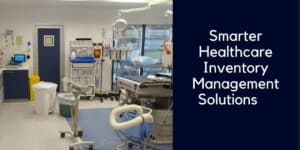What’s inside:
Healthcare providers are responding to rising staffing costs with a range of initiatives. One of the most effective ways to fight high workforce costs, while still maintaining high levels of patient care, is to improving staff productivity.
This blog looks at:
- Rising staffing costs: How healthcare providers can respond.
- Boosting efficiency: Why the staffing crisis is actually a gift for hospital C-Suite.
- Healthcare supply chain: A prime target for cost-cutting and productivity boosting exercises.
- Healthcare technology: The tools being used to reduce workload and boosts productivity.
Rising staffing costs: A persistent challenge
With a background of staff shortages and rising salaries/benefits, healthcare providers are having to scrutinize their costs and address areas of inefficiency.
Staff compensation typically counts for more than 50% of a hospital’s expenditure, and the spiraling cost of staffing/benefits is hitting hard.
2022 saw a rise of up to 11% in staffing costs.
Q1 of 2023 saw an increase of 7%, when compared with the same period last year.
There’s no end in sight for the nurse shortage. A recent study by National Council of State Boards of Nursing highlighted the scale of the issue:
100,000 nurses left the profession in the last two years due to stress, burnout and retirements.
A further 610,388 have indicated they intend to leave by 2027.
Rethinking recruitment: An innovative approach
With so many staffing gaps, there’s pressure on healthcare providers to continue hiring and use temporary staff, despite the rising costs.
However, there’s an emerging trend that looks to solve the problem in a different way.
Before jumping to fill every vacancy, maybe a better approach would be to learn how to get more done with fewer staff.
Could the power of increased productivity, driven by streamlined process and automation, enable healthcare organizations to run more efficiently with fewer staff?
Many hospitals and ambulatory surgery centers are learning to boost productivity, despite the staffing shortage in the healthcare sector.
Unlocking potential in healthcare supply chain management
The management of medical inventory often includes long labor-intensive workflows that frustrate staff and fail to deliver the accuracy and efficiency needed to effectively manage expensive medical inventory.
These processes have avoided close scrutiny for many years but are definitely in the spotlight now.
There’s been a tendency to firefight, rather than to consider the bigger picture.
Tackling waste, labor-laden workflows and simplifying supply chain activities has a direct impact on patient care, staff satisfaction and business performance. So, sometimes being challenged by financial constraints can actually be an opportunity to achieve great things.
Optimizing supply chain workflows: A pragmatic approach
So, where to start?
In terms of supply chain admin there are often very obvious contenders.
With nurse burnout so high, reducing the time and effort spent managing medical inventory can improve satisfaction levels, and frees up nurses to focus on direct patient care.
Some of things that take far too long include:
- Locating PPI and medical supplies. When undertaken promptly, this task prevents surgery delays and ensures that the surgeon has the correct items at hand to perform high quality patient care. For emergency surgery, there’s added pressure to assemble all the surgery supplies quickly, yet this may involve searching through multiple cabinets, running to other departments, or contacting materials management.
- Checking expiry dates is a vital aspect of patient care that prevents the accidental usage of unsafe products. However, when things get frantic, nurses have admitted that this important safety step can be missed out.
- Documenting the products used in surgery is crucial to ensure accurate patient records, precise inventory management and effective OR business management. However, it’s far from straight forward, with inadequate systems often leading to time consuming and error prone manual data entry.
So, what can be done to take the pressure off nurses and improve the efficiency of these tasks?
Automation is a big productivity hack for busy perioperative nurses.
It has the power to improve accuracy, efficiency and staff satisfaction.
Automation these crucial inventory management tasks that underpin the provision of care, benefits nurses, patients, and the healthcare system as a whole.
The impact of smart cabinets on surgery preparation
Smart cabinets monitor stock levels and provide real-time information that supports more effective item location, expiry management and procurement.
Top quality smart cabinets provide enhanced security, real-time inventory visibility and valuable data that supports better inventory management, reducing wastage and stockouts.
Automating inventory management takes the pressure off nurses. Stock transparency has a real impact, a Senior Cath Lab Nurse reported that the TotalSense cabinet saved 5-6 nursing hours a day!

Transforming point of care usage documentation
Nurses often speak out about the painful reality of surgical documentation.
The problem is that the systems and tools that are suitable for inventory management outside of surgical spaces simply struggle in this environment, due to the complexity of inventory usage at the point of care.
Barcode scanning fails to provide full and accurate usage documentation at the point of care.
Nurses frequently struggle to recording full item details into hospital systems and often have to manually key items in due to the failure of point of use systems.
With existing systems burdening nurses and failing to provide accurate consumption data, the market was ripe for disruption.
New image-recognition and AI technology has just come onto the market that is
especially designed to tackle the specific challenges of
documenting product usage at the point of care.

Brand-new computer vision point of use sensor technology can capture a digital image and all item data by ‘reading’ the package itself. This process takes nurses just 3 seconds.
AI, machine learning and a global product database then remove the need for the nurse to be involved in item identification – it’s now an automated task that doesn’t require a pairing in the Item Master. Once identified the item is automatically documented into the patient file and is also shared with the ERP and MMIS.
Nurses reviewing the system raved about the speedy surgical data capture achieved by Snap&Go image-recognition technology.
Finally, a system that alleviates nurses from the drudgery of documenting surgical utilization and freeing them up to focus on patients, not products.
The benefits of automated inventory management and item documentation
It’s clear to see that having a high-quality smart cabinet and using image-recognition and AI documentation technology at the point of care, slash the supply chain workload of busy nurses.
So, if you’re currently trying to manage a reduced perioperative workforce, maybe you don’t need more staff…
Maybe you just need to use new automation tools that take the supply chain admin burden off of your existing perioperative nurses – so that they can increase their productivity.
If you want to improve nurse capacity and productivity in your OR and procedure rooms, contact us to find out more about our automated inventory management solutions.








